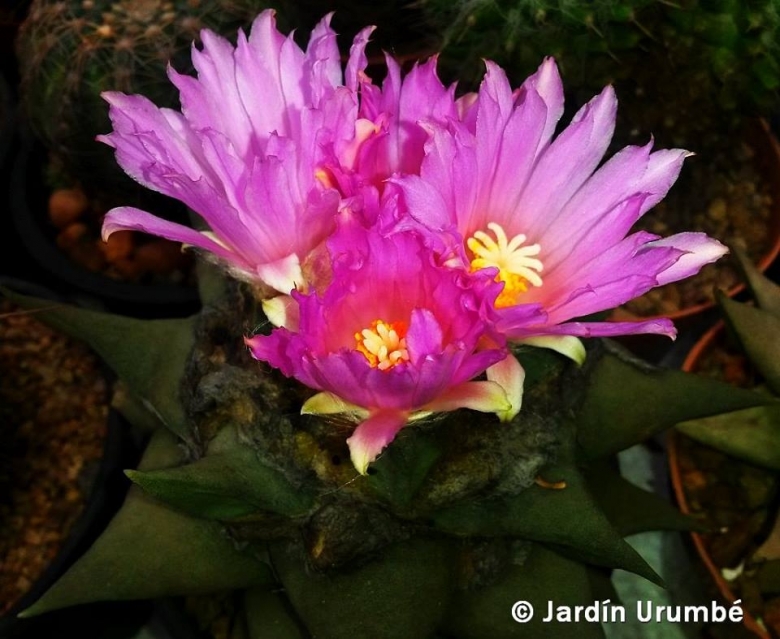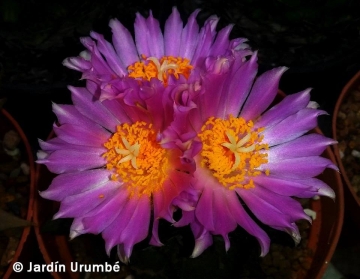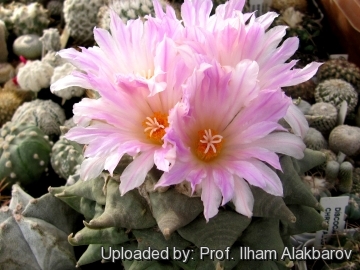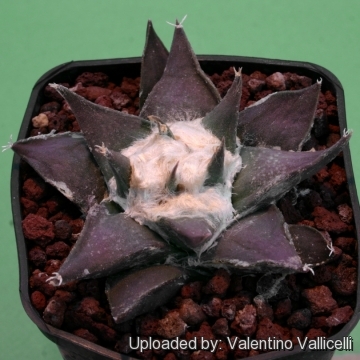Accepted Scientific Name: Ariocarpus retusus Scheidw.
Bull. Acad. Roy. Sci. Bruxelles 5: 492 (t. 1). 1838

Ariocarpus confusus Photo by: Alexander Arzberger
Origin and Habitat: Aramberri area of Nuevo Leon, Mexico
Synonyms:
See all synonyms of Ariocarpus retusus
back
Accepted name in llifle Database:Ariocarpus retusus Scheidw.Bull. Acad. Roy. Sci. Bruxelles 5: 492 (t. 1). 1838Synonymy: 31
Accepted name in llifle Database:Ariocarpus retusus subs. trigonus (F.A.C.Weber) E.F.Anderson & W.A.Fitz Maur.Haseltonia 5: 18. 1998 [1997 publ. 1998]Synonymy: 7
Cultivars
(11):
back
Common Names include:
ENGLISH: Living Rock, Star Rock
LITHUANIAN (Lietuvių): Keistasis ariokarpas
Description: Ariocarpus confususSN|2078]]SN|2078]] is a peculiar local form somewhat intermediate between Ariocarpus retususSN|2078]]SN|2079]] and Ariocarpus trigonusSN|2094]]SN|2094]]. This two taxa intergrade in the area adjacent to Aramberri (a natural hybrid?). The peculiarity of Ariocarpus confususSN|2079]]SN|2078]] is that it usually develops deep magenta flowers (a color not found in any other populations of A. retusus/trigonus), however white or pink flower or variations of the two or even bicoloured flowers in the same plant are not uncommon.
Habit: Solitary globose plant, rising slightly above ground level, rounded on top
Stem: 10 to 20 cm in diameter, 4 to 10 cm tall.
Tubercles: Upright tan brownish/green to magenta/green divergent, not crowded or basally compressed, acute at the apices, flattened and smooth adaxially, not fissured, incurved strongly, 3-8 cm long, 1-2,5 cm broad, usually more long than wide.
Root: Tap root.
Flowers: Extremely variable from Cream-white to rich magenta, 3 to 5 cm in diameter up to 4 cm long.
Blooming season: They come in late autumn or early winter.
Remarks: Ariocarpus confususSN|2078]]SN|2078]] is an extremely variable species.
Subspecies, varieties, forms and cultivars of plants belonging to the Ariocarpus retusus group
 Ariocarpus confusus Halda & Horáček: intermediates between Ariocarpus retusus and Ariocarpus trigonus flower color, white through to magenta, a color not found in any other populations. Distribution: Aramberri region.
Ariocarpus confusus Halda & Horáček: intermediates between Ariocarpus retusus and Ariocarpus trigonus flower color, white through to magenta, a color not found in any other populations. Distribution: Aramberri region. Ariocarpus elongatus (Salm-Dyck) Wettst.: has longer an narrower tubercles than Ariocarpus retusus. Distribution: Huizache, San Luis Potosí.
Ariocarpus elongatus (Salm-Dyck) Wettst.: has longer an narrower tubercles than Ariocarpus retusus. Distribution: Huizache, San Luis Potosí. Ariocarpus furfuraceus C.H.Thomps.: has equilaterally triangular shaped tubercles.
Ariocarpus furfuraceus C.H.Thomps.: has equilaterally triangular shaped tubercles. Ariocarpus furfuraceus f. cristata Frič: crested form.
Ariocarpus furfuraceus f. cristata Frič: crested form. Ariocarpus furfuraceus f. monstruosus hort.: Free branching plants with thinner elongated stems and copious production of wool. There are several different clones.
Ariocarpus furfuraceus f. monstruosus hort.: Free branching plants with thinner elongated stems and copious production of wool. There are several different clones.- Ariocarpus furfuraceus var. rostratus A.Berger: (Ariocarpus retusus var. furfuraceus ''rostratus'') Refers to plants with a more tapered apex to the tubercle.
 Ariocarpus retusus Scheidw.: (ssp. retusus) Widespread, flowers are cream or white, occasionally with reddish midveins.
Ariocarpus retusus Scheidw.: (ssp. retusus) Widespread, flowers are cream or white, occasionally with reddish midveins. Ariocarpus retusus f. cristata hort.: is a slow-growing crested cactus forming with fan shaped stems that will slowly forms brain-shaped cushion up to 3-12 cm high and 70 cm in diameter, or more.
Ariocarpus retusus f. cristata hort.: is a slow-growing crested cactus forming with fan shaped stems that will slowly forms brain-shaped cushion up to 3-12 cm high and 70 cm in diameter, or more. Ariocarpus retusus subs. horacekii Halda & Panar.: like Ariocarpus trigonus but smaller. Distribution: South of Matehuala, San Luis Potosí.
Ariocarpus retusus subs. horacekii Halda & Panar.: like Ariocarpus trigonus but smaller. Distribution: South of Matehuala, San Luis Potosí.- Ariocarpus retusus subs. jarmilae Halda, Horáček & Panar.: nomina nuda
- Ariocarpus retusus subs. panarottoi Halda & Horáček: Nomina nuda.
 Ariocarpus retusus subs. pectinatus Weisbarth: It has, dull pectinated spines already present in young specimens up to 1,2 to 2,0 mm long. The spines persist with the age. Areoles at the tips and extending on the upper side of the tubercles, elongated 2 to 20 mm long, wooly.
Ariocarpus retusus subs. pectinatus Weisbarth: It has, dull pectinated spines already present in young specimens up to 1,2 to 2,0 mm long. The spines persist with the age. Areoles at the tips and extending on the upper side of the tubercles, elongated 2 to 20 mm long, wooly.- Ariocarpus retusus subs. scapharostroides Halda & Horáček: Plants from the Villa Juarez region of SLP, it is characterized by erect angular tubercles, superficially reminiscent of Ariocarpus scapharostrus.
- Ariocarpus retusus var. sladkovskyi Halda & Kupčák
 Ariocarpus retusus subs. trigonus (F.A.C.Weber) E.F.Anderson & W.A.Fitz Maur.: (Ariocarpus retusus ssp. trigonus) Somewhat less widespread with long sharp tubercles twice as long as wide. The flowers are yellow (usually), white to pinkish white.
Ariocarpus retusus subs. trigonus (F.A.C.Weber) E.F.Anderson & W.A.Fitz Maur.: (Ariocarpus retusus ssp. trigonus) Somewhat less widespread with long sharp tubercles twice as long as wide. The flowers are yellow (usually), white to pinkish white. Ariocarpus retusus cv. Cauliflower: has a completely or partially warty skin that gives it an aspect of cauliflower.
Ariocarpus retusus cv. Cauliflower: has a completely or partially warty skin that gives it an aspect of cauliflower.- Ariocarpus retusus cv. Cauliflower King: This is a variant of cv. cauliflower with bigger, if not huge, tubercles giving an overall appearance rather globular.
 Ariocarpus retusus cv. Frumdosus: Unlike the type species, this cultivar has not convex, bulging tubers, but flat and smooth giving them an aspect of tetrahedron.
Ariocarpus retusus cv. Frumdosus: Unlike the type species, this cultivar has not convex, bulging tubers, but flat and smooth giving them an aspect of tetrahedron.  Ariocarpus retusus cv. Frumdosus brevituberosus
Ariocarpus retusus cv. Frumdosus brevituberosus Ariocarpus retusus cv. Frumdosus f. variegata
Ariocarpus retusus cv. Frumdosus f. variegata Ariocarpus retusus cv. Maruibo: Unlike the type species that has more or less triangular tubers, here they take a round shape and looks like small spheres ending with a large woolly areolae.
Ariocarpus retusus cv. Maruibo: Unlike the type species that has more or less triangular tubers, here they take a round shape and looks like small spheres ending with a large woolly areolae. Ariocarpus retusus cv. Maruibo Cauliflower: A pretty good combination of "Maruibo" and "Cauliflower" character.
Ariocarpus retusus cv. Maruibo Cauliflower: A pretty good combination of "Maruibo" and "Cauliflower" character. Ariocarpus retusus cv. Maruibo Pectinatus: is characterized by the swollen tubercles of "Maruibo" together with the very woolly and sometimes prickly central groove of "Pectinatus".
Ariocarpus retusus cv. Maruibo Pectinatus: is characterized by the swollen tubercles of "Maruibo" together with the very woolly and sometimes prickly central groove of "Pectinatus". Ariocarpus retusus cv. Mituibo: (a.k.a. cv. Three Finger or Tresfinger)The tip of each tubercles is split into three points as three fingers, a bit like a trident with a large central section and two smaller ones on each side.
Ariocarpus retusus cv. Mituibo: (a.k.a. cv. Three Finger or Tresfinger)The tip of each tubercles is split into three points as three fingers, a bit like a trident with a large central section and two smaller ones on each side. Ariocarpus retusus cv. Tama Botan: (a.k.a. Ariocarpus retusus var. major) It is a cultivated selection with very wide leaflike, divergent tubercles. The tubercles are 3,5 to 5 cm wide, and are as wide as long or wider in adult specimens.
Ariocarpus retusus cv. Tama Botan: (a.k.a. Ariocarpus retusus var. major) It is a cultivated selection with very wide leaflike, divergent tubercles. The tubercles are 3,5 to 5 cm wide, and are as wide as long or wider in adult specimens.
Notes: Ariocarpus confususSN|2094]]SN|2078]] is a controversial taxon erected by Halda & Horacek in 1998 to indicate the plants of the Ariocarpus retususSN|2079]]SN|2079]]/trigonus complex found in several locations around in the Aramberri region. This Ariocarpus are extremely variable in body form, and also in flower colour. Aramberri is located in a valley between two mountain slopes. On either side of the valley one may find population that looks like the typical Ariocarpus retususSN|2079]]SN|2079]] while other resembles the typical Ariocarpus trigonusSN|2078]]SN|2094]], with a range of intermediates between the two. Morphologically, plants belonging to the confusus species resemble either the retusus ssp or the trigonus ssp. However, they are easily distinguished from either of these retusus sub-species by their interesting variation is in the flower color, which can range from white through to magenta, a color not found in any other populations of A. retusus/trigonus. Bicoloured flowers also occur.
Bibliography: Major references and further lectures
1) Edward F. Anderson “The Cactus Family” Timber Press, 2001
2) Curt Backeberg “Cactus Lexicon” Sterling Publishing Company, Incorporated, 1978
3) Hiroshi Hirao “Colour encyclopaedia of cacti” Japan 1979 (Japanese language and script)
4) Willy Cullmann, Erich Götz (Dozent Dr.), Gerhard Gröner “The encyclopedia of cacti” Portland, OR: Timber Press, 1986
5) David Hunt, Nigel Taylor “The New Cactus Lexicon” DH Books, 2006 ISBN 0953813444, 9780953813445
6) James Cullen, Sabina G. Knees, H. Suzanne Cubey “The European Garden Flora Flowering Plants: A Manual for the Identification of Plants Cultivated in Europe, Both Out-of-Doors and Under Glass” Cambridge University Press, 11/Aug./2011
 Ariocarpus confusus Photo by: Alexander Arzberger
Ariocarpus confusus Photo by: Alexander Arzberger Ariocarpus confusus Photo by: Prof. Ilham Alakbarov
Ariocarpus confusus Photo by: Prof. Ilham Alakbarov Ariocarpus confusus Photo by: Valentino Vallicelli
Ariocarpus confusus Photo by: Valentino Vallicelli - SB1426, Marmelajo, Nuevo Leon. This is the classical form of the plant with deep magenta flowers (Note that the magenta pigment also tinges the tubercles) Photo by: Valentino Vallicelli
- SB1426, Marmelajo, Nuevo Leon. This is the classical form of the plant with deep magenta flowers (Note that the magenta pigment also tinges the tubercles) Photo by: Valentino VallicelliCultivation and Propagation: This species is slow growing if compared with other retusus forms, but of easy culture in a well drained non-organic free draining soil compost, with ample water during the growing season. Use of a weak low-nitrogen fertilizer during the growing season can encourage growth. The main threat to their development is root rot. Ariocarpus should be kept dry whenever there is a threat of cold. The appearance of Ariocarpus can benefit greatly by watering the plants from the bottom. This practice will help to keep the “wool” on the top of the plant from becoming matted or discoloured. Need light shade to full sun. Frost Tolerance: Hardy to -10°
Propagation: Seed, but will generally take about 6-10 years to reach flowering size, occasionally grafted.














